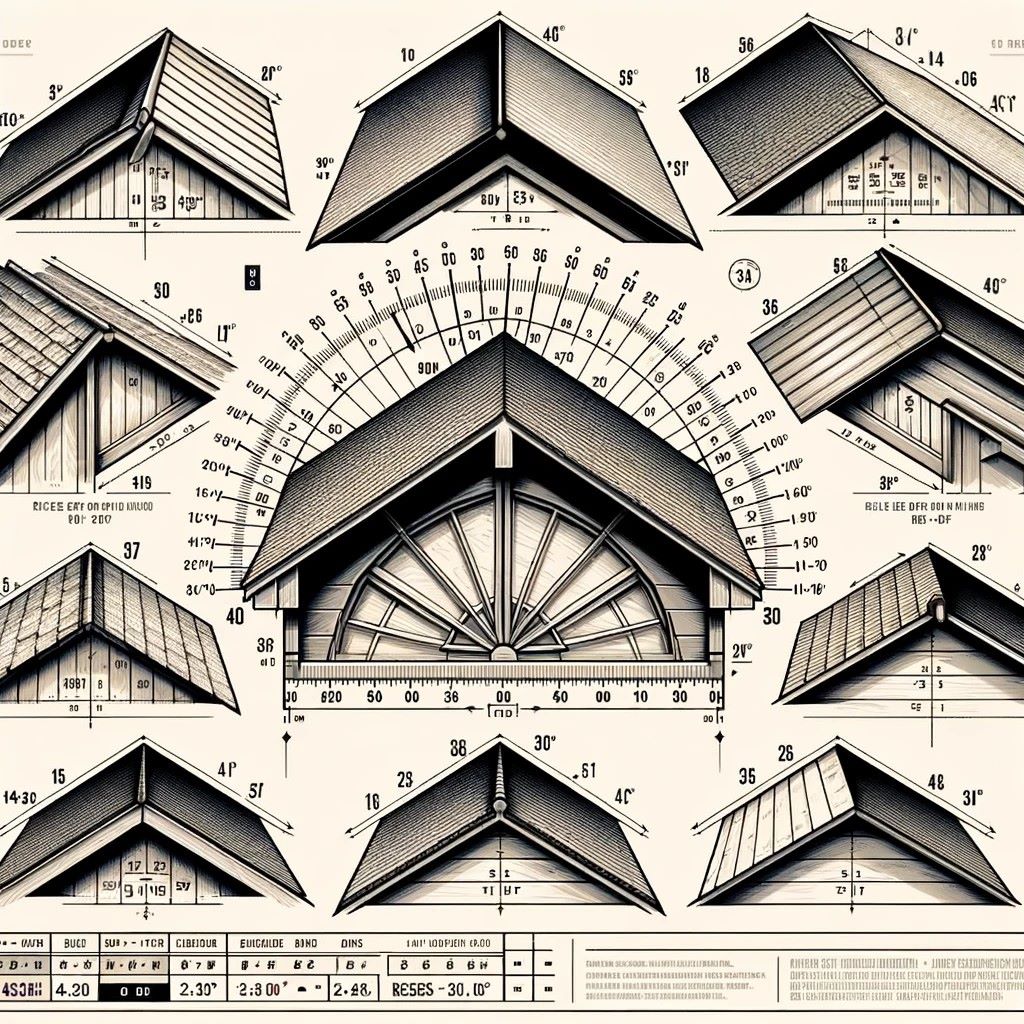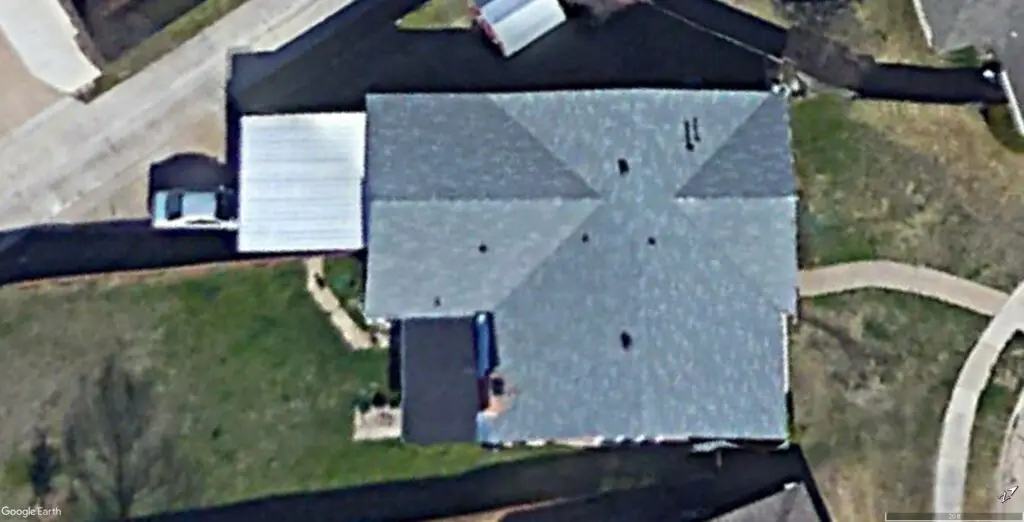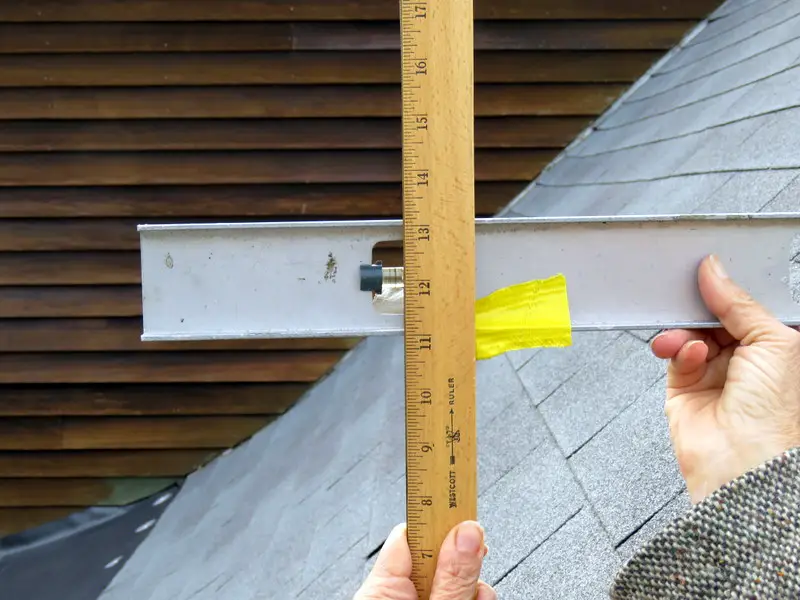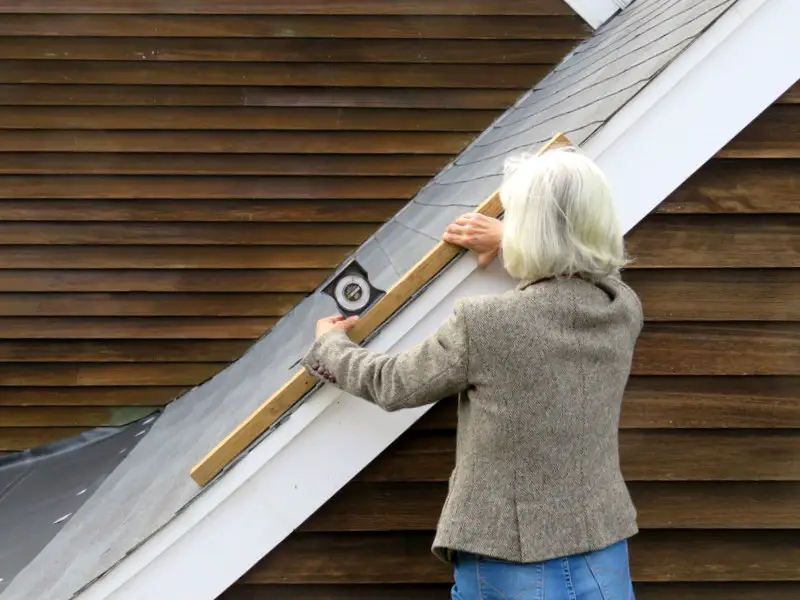How to Calculate Roof Area with Pitch and Footprint
By Jack Gray, Roof Online Editor • Last updated September 28, 2023

Table of Contents
- Introduction
- Find the Area of a Roof: Short Version
- Find the Area of a Roof: Long Version
- Notes on Calculating the Area of a Roof
- Roof Pitch Multiplier Chart
- Related Articles
Introduction
I’ve been calculating roof areas for real roofs for over 20 years now. An accurate accounting of total roof area is pretty important when you bill your clients based on roof square footage. (We bill roof maintenance programs and roof condition assessments based on the size of the roof.)
The last thing you want is to get the total square footage wrong and end up with a billing dispute or to find out you’ve been undercharging…
Here’s a run through of how you can get a very accurate measurement of the total actual surface area of your roof.
We also created a calculator that calculates the surface area of a roof based on width, length, and slope inputs, if that’s what you’re actually looking for.
Find the Area of a Roof: Short Version
- Determine the square footage of the area covered by your roof.
- Figure out the pitch of your roof.
- Look up the roof pitch multiplier for that pitch.
- Multiply the square footage of the covered area by the roof pitch multiplier.
- Done. You’ve found the area of a roof.
Find the Area of a Roof: Long Version
Formula for the Area of a Roof
The formula for determining the area of a roof is very simple. It’s area (of a roof’s footprint) x roof pitch multiplier = surface area of a roof.
Actually using the formula is much more difficult because you have to figure out the area of the roof’s footprint, the slope of the roof, and the roof pitch multiplier before you have useful values to plug into the formula.
And you may have to do that for multiple roof sections on the same building.
All of that can be tricky.
Find the Area of the Roof’s Footprint
Determine the area of the roof’s footprint, which is the area covered by a roof regardless of slope (or the apparent area of a roof when you look straight down at it, like from a satellite).
Google Earth Pro makes finding the area of a roof’s footprint pretty easy with the measuring tools they have available, but you can also simply measure the dimensions of the building on the ground and figure out the area that way (see our page here for help measuring with Google Earth).
Don’t forget to take into account overhanging eaves or any other areas where the roof extends beyond the exterior walls of the building.
You will also need to increase your total footprint area to include any areas where one roof section overhangs another roof section. You’ll probably be trying to estimate the entire area of a roof.

Expressing Slope in Standard Pitch
Note: All of these calculations work the same whether you are using inches or centimeters. You just have to plug the numbers in. A roof that rises 10 cm for every 30 cm of horizontal distance has the same slope as a roof that rises 4 inches for every 12 inches of run.
In the U.S., the slope of the roof is typically given in standard pitch, which is a ratio expressed as “rise-in-run”, “X-in-12″, or “X:12”.
Traditionally, “12″ is always used as the run, because there are twelve inches in a foot, and you are stating how many inches the roof rises vertically for every foot the roof spans horizontally.
Pitched roofs commonly have slopes between 4-in-12 (6:12) and 12-in-12 (12:12). A roof that goes up at a 45-degree angle has a slope of 12:12.
Expressing Roof Slope in Degrees
The rest of the English-speaking world uses degrees, which seems simpler, but it takes a few extra steps to figure it out mathematically.
It also doesn’t immediately convey as much information about the roof on a practical level as the rise-in-run ratio expression.
To express the slope in degrees, you divide the rise by the run and find the inverse tangent of the result.
But you still need to know the rise and the run, the “X-in-12”, in order to find the roof slope in degrees, unless you’re using a slope finder that tells you the slope in degrees.
Find the Pitch of the Roof
Before you can determine the area of a roof, you need to know its pitch. You can find the roof pitch by getting up on a ladder at the rake edge of the roof (the sloping edge) and measuring with a ruler and a spirit level, or you can use a specially-designed slope finder.
(If you want to know the slope of anything with amazing accuracy and you like cool new tools, you should check out this digital level.
It may be way too expensive for what you need, but this is what professionals use. It will tell you the slope of your roof in degrees, rise/run, or percentage, and automatically convert from one to the other.)

You could also take your measurement in the attic using the underside of a rafter, the underside of the roof sheathing, or even the ceiling, if you’re sure that it follows the slope of the roof.
Eyeballing the slope and guessing (like “well, it looks like it goes up 6 feet for every 12 feet it goes across, so it’s about a 6:12 slope) is probably not a good idea.
The result you get from guessing like this might be close enough for government work, but if it’s a large roof and you’re a roofer with a 10% profit margin, I wouldn’t recommend it.
There are also a number of smartphone apps that you can use to find the slope of your roof, if you have a clear view of a gable end on the building. These can be acceptably accurate sometimes.
You don’t have to get up on the roof or go to the attic to use these. Go search in your app store for “roof pitch” apps. You’ll see.

Determine the Roof Pitch Multiplier
Note: If you already know the roof slope in degrees, then all you have to do to find the roof pitch multiplier is find the secant using a scientific calculator.
For example, if the roof slope angle is 45°, then sec(45) = 1.414213. That will be your roof slope multiplier.
So, to proceed.
Once you have the slope of the roof expressed in standard pitch, you can consider yourself in possession of the lengths of the a and b sides of a right triangle. Now you need to pull out your trusty Pythagorean Theorem and figure out the length of the hypotenuse.
A good calculator can be found at web2.0calc.com.
As I’m sure you remember, a² + b² = c². So, if your slope is 6:12,
6² + 12² = c²
36 + 144 = c²
180 = c²
√180 = c
13.416 = c
So 13.416 is the length of the hypotenuse.
Now that you have the length of your hypotenuse, 13.416, you want to think of that as the length of a line on the actual sloped roof surface over a horizontal distance of 12 inches. You want to find out how much longer that line is than the 12 inches it covers.
You will express this difference as a number, called the roof pitch multiplier (also called the roof pitch factor, roof slope factor, or roof slope multiplier).
Once you know the roof pitch multiplier for any particular roof slope, you can use it to find the actual area of a roof of any size that has the same slope.
So in this case, for every 12 inches the roof goes across horizontally (b), while rising 6 inches (a), there’s actually 13.416 inches of roof (c).
If you divide the 13.416 inches by the 12 inches (c/b), that gives you 1.118.
So the actual roof surface, if it were laid down flat on the ground, would be 1.118 times larger than the footprint of the roof. And for a roof with a slope of 6:12, that number, 1.118, is your roof pitch multiplier.
Calculate the Surface Area of the Roof
Take the area of a roof’s footprint, say it’s 5,000 square feet, and multiply 5,000 by 1.118.
That gives you 5,590 square feet, which is the actual area of the surface of the roof. And that’s what you were looking for.
This applies to rafter lengths as well as areas. A rafter for a roof with a 6:12 slope will be 1.118 times as long as the horizontal length that it covers.
Notes on Calculating the Area of a Roof
- If the roof has areas with different slopes, as on a gambrel roof, you’ll have to figure out more than one slope and use the appropriate roof slope multiplier for the different areas.
- As a shortcut, the roof slope multiplier for any slope can be determined by finding the square root of ((rise/run)² + 1).Divide the rise by the run. Square the result. Add 1 to the result of that. Find the square root of that result.
- If you know the roof slope in degrees, simply find the secant using a scientific calculator. For example, if the roof slope is 45°, then sec(45) = 1.414213. That’s your roof slope multiplier.
Roof Pitch Multiplier Chart
Since the roof slope (or “roof pitch” – these terms are generally used interchangeably in this context) multiplier is so important to estimating the area of a roof, we’ve put together a quick reference chart.
We also have a much more complete roof slope multiplier chart that includes slopes by the half inch and slopes up to 30.5-in-12.
If you’re using the table below to help you figure out the area of a roof, you should consider getting yourself a construction calculator. That way you can instantly calculate the factor for any slope, among many other useful things. This one is very good.
| Roof Pitch | Slope In Degrees | Roof Pitch Multiplier |
|---|---|---|
| 1:12 | 4.76° | 1.003 |
| 2:12 | 9.46° | 1.014 |
| 3:12 | 14.04° | 1.031 |
| 4:12 | 18.43° | 1.054 |
| 5:12 | 22.62° | 1.083 |
| 6:12 | 26.57° | 1.118 |
| 7:12 | 30.26° | 1.158 |
| 8:12 | 33.69° | 1.202 |
| 9:12 | 36.87° | 1.250 |
| 10:12 | 39.81° | 1.302 |
| 11:12 | 42.51° | 1.357 |
| 12:12 | 45° | 1.414 |
| 13:12 | 47.29° | 1.474 |
| 14:12 | 49.4° | 1.537 |
| 15:12 | 51.34° | 1.601 |
| 16:12 | 53.13° | 1.667 |
| 17:12 | 54.78° | 1.734 |
| 18:12 | 56.31° | 1.803 |
| 19:12 | 57.72° | 1.873 |
| 20:12 | 59.04° | 1.944 |
| 21:12 | 60.26° | 2.016 |
| 22:12 | 61.39° | 2.088 |
| 23:12 | 62.45° | 2.162 |
| 24:12 | 63.43° | 2.236 |
| 25:12 | 64.36° | 2.311 |
| 26:12 | 65.22° | 2.386 |
| 27:12 | 66.04° | 2.462 |
| 28:12 | 66.80° | 2.539 |
| 29:12 | 67.52° | 2.615 |
| 30:12 | 68.20° | 2.693 |
About the Author
Jack Gray is a principal roof consultant and vice president at the Moriarty Corporation, an award-winning building enclosure consultant firm founded in 1967. He is also the editor of the Roof Online website.

Mr. Gray has worked in the roofing industry for over 25 years, with training and practical experience in roof installation, roof inspection, roof safety, roof condition assessment, construction estimating, roof design & specification, quality assurance, roof maintenance & repair, and roof asset management.
He was awarded the Registered Roof Observer (RRO) professional credential in 2009.
He also served as an infantry paratrooper in the 82nd Airborne Division and has a B.A. from Cornell University. Read full bio.